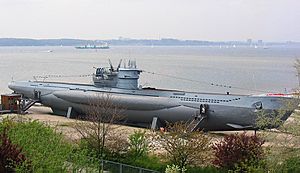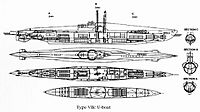German submarine U-1022 facts for kids
class="infobox " style="float: right; clear: right; width: 315px; border-spacing: 2px; text-align: left; font-size: 90%;"
| colspan="2" style="text-align: center; font-size: 90%; line-height: 1.5em;" | 
|}
German submarine U-1022 was a special type of German submarine, called a Type VIIC/41 U-boat. It was used by Nazi Germany's navy, the Kriegsmarine, during World War II. This submarine was built in Hamburg, Germany, and officially started its service on June 7, 1944. This was just one day after the D-Day landings in Normandy, when Allied forces arrived in France. U-1022 was commanded by Kapitänleutnant Hans-Joachim Ernst. During its time in service, it sank two ships. After the war ended, U-1022 was given to the Allies and later sunk as part of something called Operation Deadlight.
Contents
| History | |
|---|---|
| Name | U-1022 |
| Ordered | 13 June 1942 |
| Builder | Blohm & Voss, Hamburg |
| Yard number | 222 |
| Laid down | 6 May 1943 |
| Launched | 13 April 1944 |
| Commissioned | 7 June 1944 |
| Fate |
|
| General characteristics | |
| Class and type | Type VIIC/41 submarine |
| Displacement |
|
| Length |
|
| Beam |
|
| Height | 9.60 m (31 ft 6 in) |
| Draught | 4.74 m (15 ft 7 in) |
| Installed power |
|
| Propulsion |
|
| Speed |
|
| Range | |
| Test depth |
|
| Complement | 44-52 officers & ratings |
| Armament |
|
| Service record | |
| Part of: |
|
| Commanders: |
|
| Operations: |
|
| Victories: |
|
Building and Design of U-1022
U-1022 was a Type VIIC/41 submarine. These submarines were an improved version of earlier Type VIIC models. The building of U-1022 began on May 6, 1943, at a shipyard called Blohm & Voss in Hamburg, Germany. It was finished and launched into the water on April 13, 1944.
How Big Was U-1022?
When U-1022 was on the surface of the water, it weighed about 759 tons. When it was underwater, it weighed about 860 tons. The submarine was about 67.10 meters (around 220 feet) long from end to end. Its main body, called the pressure hull, which kept the crew safe from the deep-sea pressure, was about 50.50 meters (around 165 feet) long.
The widest part of the submarine was about 6.20 meters (around 20 feet). Its height was about 9.60 meters (around 31 feet), and it sat about 4.74 meters (around 15 feet) deep in the water.
How U-1022 Moved
U-1022 had two types of engines to help it move. On the surface, it used two powerful diesel engines. These engines could make the submarine go as fast as 17.7 knots (about 20 miles per hour). When it was underwater, it switched to two electric motors. These motors allowed it to travel at a speed of 7.6 knots (about 8.7 miles per hour).
The submarine could travel a very long way on the surface, about 8,500 nautical miles (around 9,780 miles) if it went slowly. Underwater, it could travel about 80 nautical miles (around 92 miles) before needing to surface or recharge. U-1022 was designed to dive very deep, up to 230 meters (about 755 feet).
Weapons of U-1022
U-1022 was armed with several weapons to attack enemy ships and defend itself. It had five torpedo tubes, which are special launchers for torpedoes. Four of these were at the front (bow) and one was at the back (stern). It carried 14 torpedoes in total.
For fighting on the surface, it had one large 8.8 cm naval gun. It also had anti-aircraft guns to protect itself from planes. These included one 3.7 cm Flak M42 gun and two smaller 2 cm C/30 anti-aircraft guns. The submarine usually had a crew of about 44 to 60 sailors.
U-1022's Time in Service
U-1022 was ordered by the German navy on June 13, 1942. After it was built and launched, it was officially put into service on June 7, 1944. After its training period, which included a trip from Germany to Norway, U-1022 started its first and only war patrol.
This patrol began from its home port of Bergen, Norway. It lasted for 49 days, during which U-1022 traveled to the southern coast of Iceland. During this mission, the submarine successfully sank two enemy ships. It sank the Panamanian merchant ship Alcedo, which weighed 1,392 tons. It also sank a British vessel called HMT Southern Flower, which weighed 328 tons.
U-1022 returned to Bergen on April 1, 1945, and stayed there for the rest of the war. After Germany lost the war, U-1022 and many other German submarines were sunk by the Allies in an event known as Operation Deadlight. This was done to prevent them from being used again.
Summary of Ships Sunk
| Date | Ship Name | Nationality | Tonnage (GRT) |
Fate |
|---|---|---|---|---|
| 28 February 1945 | Alcedo | 1,392 | Sunk | |
| 3 March 1945 | HMT Southern Flower | 328 | Sunk |
See also


